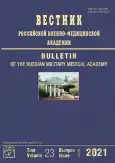Experience of using the «Bark Vibrolung» device in the complex treatment of community-acquired pneumonia
- Authors: Salukhov V.V.1, Kharitonov M.A.1, Makarevich A.M.2, Bogomolov А.B.1, Kazantsev V.A.1, Ivanov V.V.1, Chugunov A.A.1, Morozov M.A.2
-
Affiliations:
- Military Medical Academy named after S.M. Kirov
- 301 military clinical hospital
- Issue: Vol 23, No 1 (2021)
- Pages: 51-58
- Section: Clinical trials
- URL: https://journals.rcsi.science/1682-7392/article/view/63576
- DOI: https://doi.org/10.17816/brmma63576
- ID: 63576
Cite item
Abstract
Currently, much attention is paid to pathogenetic methods of treatment of community-acquired pneumonia. As a rule, pneumonia is accompanied by a violation of the balance of formation and discharge of bronchial secretions. In order to normalize the drainage function of the bronchi, both pharmacological and mechanical methods of influencing the muciliary clearance are successfully used. The comprehensive use of the entire arsenal of therapeutic capabilities allows you to minimize the duration of the patient's stay in a hospital bed, as well as speed up the process of restoring impaired lung functions after pneumonia. The study was conducted in the pulmonology Department of the district hospital of the Eastern military district. The effectiveness of using the device of vibroacoustic influence on the chest using the BARK VibroLUNG device in the treatment of community-acquired pneumonia was studied. In addition to the traditional therapy regimens, 5 to 7 sessions of hardware vibration massage were performed. In patients who received a course of vibroacoustic massage, there was a decrease in the duration of General intoxication, productive cough, and physical signs of lung tissue consolidation. Regression of the main clinical manifestations of pneumonia was accompanied by an increase in sputum discharge, simultaneously with a decrease in the time of its production. The main group of patients was characterized by the best time for normalization of acute-phase indicators, restoration of lung ventilation function, and resolution of pneumonic infiltration according to X-ray data. The use of a course of vibration exposure to the chest allowed to reduce the duration of stationary treatment by an average of 3 days.
Full Text
##article.viewOnOriginalSite##About the authors
Vladimir V. Salukhov
Military Medical Academy named after S.M. Kirov
Email: vlasaluk@yandex.ru
Doctor of medical sciences, docent
Russian Federation, Saint PetersburgMikhail A. Kharitonov
Military Medical Academy named after S.M. Kirov
Email: micjul11@yandex.ru
Doctor of medical sciences, professor
Russian Federation, Saint-PetersburgAnrdey M. Makarevich
301 military clinical hospital
Email: makar-kha@yandex.ru
Candidate of medical sciences
Russian Federation, KhabarovskАlexey B. Bogomolov
Military Medical Academy named after S.M. Kirov
Author for correspondence.
Email: bg-ab@mail.ru
Сandidate of medical sciences
Russian Federation, Saint-PetersburgVictor A. Kazantsev
Military Medical Academy named after S.M. Kirov
Email: victor.kazantsev@mail.ru
Doctor of medical sciences, professor
Russian Federation, Saint-PetersburgVladimir V. Ivanov
Military Medical Academy named after S.M. Kirov
Email: sea-89@yandex.ru
Сandidate of medical sciences
Russian Federation, Saint-PetersburgAlexander A. Chugunov
Military Medical Academy named after S.M. Kirov
Email: alexandrchugun@yandex.ru
Аdjunct
Russian Federation, Saint-PetersburgMaksim A. Morozov
301 military clinical hospital
Email: tvmi-morozov@bk.ru
Head of the pulmonary department
Russian Federation, KhabarovskReferences
- Rachina SA, Sinopalnicov AI. Clinical practice guidelines for community-acquired pneumonia in adults: what awaits us in 2019. Practicheskaya pulmonologiya. 2018;(3):8–13 (In Russ.)
- Svedeniya ob infekcionnyh i parazitarnyh zabolevaniyah za yanvar' – dekabr' 2018 g. Sanitarnyj vrach. 2019;(3):21 (In Russ.)
- Diagnostika, lechenie i vakcionoprofilaktika vnebol'nichnoj pnevmonii u voennosluzhashchih: metodicheskie ukazaniya / Yu.V. Ovchinnikov, et al. Moscow: GVKG im. N.N. Burdenko; 2016. 58 p. (In Russ.)
- Prakticheskaya pul'monologiya: rukovodstvo dlya vrachej. Ed. by V.V. Saluhova, M.A. Haritonova. Moscow; Gеоtar-Media; 2017. 417 p. (In Russ.)
- Komlev AD, Korovina OV, Soboleva LR. Resultati broncholegochnogo obsledovania bolnih vnegospitalnoy pnevmoniei. (Conference proceedigs). Nacionalniy congress po bolesnam organov dihaniya; Moscow; 1997. 998 p. (In Russ.)
- Sinopalnikov AI, Zaicev AA. «Trudnaya» pnevmonia. Moscow; 2010. (In Russ.)
- Diagnostika, lechenie i profilaktika vnebol'nichnyh pnevmonij tyazhelogo techeniya u voennosluzhashchih: metodicheskie rekomendacii / N.N. Ryzhman, et al. Saint Petrsburg: VMA; 2014. 60 р. (In Russ.)
- Chucalin AG. Zatagnaya pnevmonia. Pulmonologiya. 2014;(3):5–10 (In Russ.)
- Parfyonov SA, Borovkov EYu, Shagvaliev AG, et al. Sovremennye napravleniya profilaktiki vnebol'nichnoj pnevmonii u voennosluzhashchih, prohodyashchih voennuyu sluzhbu po prizyvu Antibiotiki i himioterapiya. 2018;63(1–2):38–43. (In Russ.)
- Chernehovskaya NE, et al. Compleksnaya diagnostika I lecheneye bolnih pneumoniey. Endoscopia. 2013;(2):11–17. (In Russ.)
- Zaicev AA. Adjuvantnaya (neantimicrobnaya) terapiya vnebolnichnoy pnevmonii. Consilium Medicum. 2016;(1):17–22. (In Russ.)
- Сhikina SU, Belevskiy AS. Mukociliarniy kliriens v norme i patologii. Atmosphera. Pulmonologiya I allergologia. 2012;(1):2–5. (In Russ.)
- Avdeev SN. Practicheskiye aspect nebulaisernoy terapii. Rossijskij medicinskij zhurnal. 2014;(25):1866–1872. (In Russ.)
- Fomenko AV, et al. Ocenka effectivnosti compleksnogo lecheneya zabolevaniy broncholegoschnoy sistemi s ispolsovaniem apparata The vest airway clearance system. Pulmonologiya. 2011;(1):81–84. (In Russ.)
- Ivanov VV, Haritonov MA, et al. Lechebnie effecti vibracionno-kompressionnogo vosdeystviya na grudnuyu kletku pri vnebolnichnoy pnevmonii. Pulmonologiya. 2015;(2):187–195. (In Russ.)
- Avdeev SN, Guseva NA, Nuralieva GS. Effectivnost metoda visochastotnih kolebaniy grednou stenki pri obostrenii hronicheskoy obstruktivnoy bolesnyu legkih. Pulmonologiya. 2016;(30):466–1472. (In Russ.)
- Usenko DV. Visokochastotnaya oscilaciya grudnoi kletki v lechenii detei s ostroy vnebolnichnoy pnevmoniey. Sovremennaya pediatriya. 2018;(96):55–59. (In Russ.)
- Zaytsev AA, Kharitonov MA, Chernetsov VA, Kryukov YeV. Sovremennyye vozmozhnosti nebulayzernoy terapii. Meditsinskiy sovet. 2019; 15: 106–111. (In Russ.)
Supplementary files









